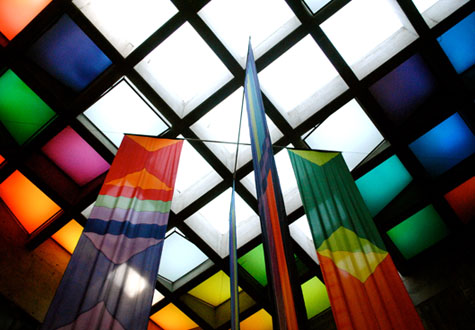To enter the Rose Room at Brescia University College (figure 1), visitors must first make their way up a set of stairs leading to the stunning Ursuline Hall (figure 2). The appearance of the Tudor Gothic style building, made of grey and red Trent Valley stone, fills visitors with an immediate sense of its historical significance. Brescia University College, a women’s university, was founded by the Ursuline Religious Order of the Diocese of London, a group of women committed to social justice, community service, and the development of women, who sought to expand women’s education. Originally called Brescia Hall, Ursuline Hall was erected in 1924-25. It was built by contractor Joseph Michael Piggot, and was largely paid for by Josephine Gaukler, a great benefactress of the Ursuline sisters whose picture hangs in the Rose Room (figure 3). Ursuline Hall’s practical uses include a residence for students, a chapel, and a community/social room. Visitors are required to obtain a key from the reception desk in Ursuline Hall in order to gain access to the Rose Room, which is currently used as a meeting room or for college celebrations and receptions. For more historical information visit Brecia’s history page.
When entering the Rose Room, it feels like stepping into a time that no longer exists. It certainly doesn’t feel like most of the locations on campus that I am used to as a student - the Social Science Centre, or the John Labatt Visual Arts Centre, are both constantly filled with student activity, and have been modernized to suit the needs of these students. The Rose Room has an entirely different aura that is characterized by its distinctive historical style. The room lets in a minimal amount of light; the windows are covered in lace curtains as well as heavy, overhanging velvet curtains. The left side of the room looks like a formal dining area, with a long, intricately carved buffet along the wall and a large table, while the right side of the room is a sitting area, anchored around the fireplace. The room is balanced by two large paintings hanging on opposite ends of the room: St. Anthony above the mantelpiece (figure 4), and Madonna of the Chair above the buffet. There is a sense of stillness in the room, a sense that if you listened hard enough, the objects might do the talking for you. I can imagine drinking tea in this room at a time when the candleholders on the corner table held candles - they are designed with holes in the top so that the candles would heat the room - instead of the light bulbs they now contain. The room is filled with a rich colour palette; deep red, gold, blue, and brown hues accent the room, complemented by the combination of different textures in the wallpaper, carpet, curtains, and antique furnishings. Collectively, the design elements in this room create a sense of historic preservation.
From the beginning, it seems that Ursuline Hall was designed with historical conservation in mind. Its early contributors sought out unique furnishings and details, such as the Spanish Varguena (figure 5), or writing desk, which was purchased in Palm Beach, Florida by Colonel MacLean (of the MacLean Publishing Company), which is thought to have been carved during the Spanish Renaissance (1500-1650). MacLean believed that Ursuline Hall would not only provide a space to conserve this unique piece, but also that it would be valued there. The contractor himself donated the mantelpiece, found at Ryan’s Antique Shop in Toronto in 1925. The consideration taken by Ursuline Hall’s founding figures regarding the inclusion of many antique pieces from different historical eras is evident in the Rose Room; they envisioned it as a place on campus where Brescia’s historical significance would be showcased and appreciated.
The Rose Room embodies the sense of eclecticism, with a variety of influences and elements from different historical styles, that we discussed in a VAH3387 lecture at the University of Western Ontario. The unique furnishings in this room are reminiscent of the eclectic moment of the Victorian period. Different pieces of furniture have been brought in from different historical moments, combined with the Tudor Gothic style architecture of the building itself. The Gothic style, inspired by the church, represents a moralistic way of life.According to A.W.N. Pugin, it was an architectural model that, if followed, would improve society. This moralistic model signifies the elevated, honorable values that the Ursuline sisters hoped the school would be based upon. Although the Gothic period occurred much earlier than Ursuline Hall was built, this video demonstrates some Gothic elements which can be found at Ursuline Hall: the exterior architectural style, as well as an archway at the base of a marble staircase in the hallway leading to the Rose Room and stained glass windows in the chapel. In addition to some Gothic features, the glass vases on the mantelpiece reflect a Byzantine style of art, the paintings are replicas from Europe in the 1600s, and much of the glass and china were purchased at auction sales by some of the founding women of Brescia University College. The amalgamation of historical objects and details within the room itself soften the space and generate interest. In this sense, the interior of the Rose Room works hand-in-hand with the exterior of the building by creating a design that integrates many historical elements.
|













